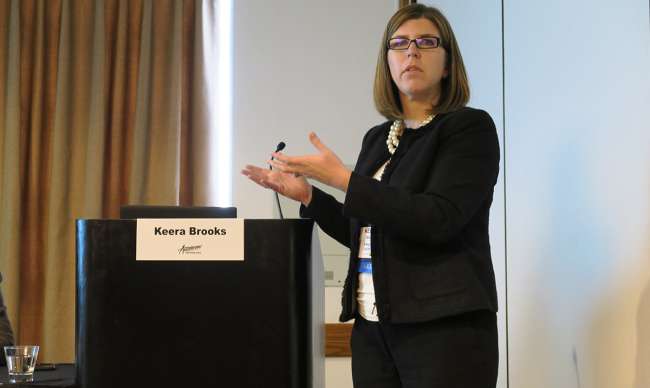Staff Reporter
For Women in Trucking, Retaining Just as Crucial as Recruiting

KANSAS CITY, Mo. — Increasing the number of women in the trucking industry is as much a matter of recruiting new talent as it is a matter of retaining the employees that are already there, according to Keera Brooks, CEO of Sawgrass Logistics.
Ellen Voie, president of the Women In Trucking Association, approached Sawgrass Logistics, a Women’s Business Enterprise National Council-certified logistics company, to conduct a survey on best practices for engaging women in trucking. Brooks revealed the results of the survey, which was conducted online over the course of a few weeks this summer, at the Women In Trucking Association’s annual conference Nov. 7.
Part of the survey measured Net Promoter Score, an index ranging from minus-100 to 100 that measures the willingness of customers to recommend their own company, product or field. Brooks said that women scored an 11, while men scored a 75. That is, men in the trucking industry were far more likely to recommend trucking as a career path than women in the industry were.
“We need to change the conversation from recruiting drivers to thinking about whole driver lifecycle. This is about getting people into seats and supporting them until they exit. I think that’s really where we miss the boat,” Brooks said. “We could be cannibalizing our own pipeline by not caring for the people who are sitting in the seat today. If you just focus on the people that are there today, you can get so much more power out of the resources that you’re spending on bringing people in.”
If the customer walked in and they didn’t have restroom facilities [for women], would the customer want to ship with us?
Jason Williams, president of Expediter Services
The survey found that 83% of women enter the trucking industry because they were referred by a friend of family members.
Brooks said that marketing strategies that are meant to attract women for driving jobs typically focus on home time and equal pay, but safety is actually a bigger concern. She said safety encompasses everything from sleeping in cabs to using equipment to driving into dim yards.
“Women that feel good about themselves are more confident,” Brooks said. “We are here and we are worth targeting. We want the women to go where the women are wanted.”
In the survey, respondents voiced concern that some truck stops lack basic necessities such as separate restrooms and showers, cleanliness, free coffee and laundry facilities. Brooks said that some bathrooms and showers that are meant to be shared between men and women do not have locks on the stall doors.
Women CAN excel in the trucking industry! https://t.co/3FDWPKengr #3PLTLC #trucking pic.twitter.com/J9dJMeEg9y — BlueGrace Logistics (@MyBlueGrace) November 8, 2017
Jason Williams, president of Expediter Services, said the best carriers treat their drivers like customers.
“If the customer walked in and they didn’t have restroom facilities, would the customer want to ship with us? If they walked in and everything was dirty, would they want to do business with us?” Williams said. “A lot of it is just having the focus to say, ‘We’re going to treat that truck [driver] like a customer’ and the carriers that we see are successful do it that way.”
Brooks said the survey found that women make up about 6% of today’s drivers and that driver turnover has reached 90%, the highest it has been since 2015. In addition to a lack of women, trucking faces an overall lack of drivers. The trucking industry is short 48,000 drivers, according to American Trucking Associations.
Brooks said that lowering the commercial driver license age from 21 to 18 could address this shortage by opening possibilities for an important sector of young people, namely recent high school graduates.
Ramona Hood, vice president of FedEx Transportation Management, also suggested that lowering the CDL eligibility age could bring more people into the industry. Hood was last year’s recipient of the Influential Woman In Trucking award, which the Women In Trucking Association bestows every year.
“Do it at the right age. From a regulatory standpoint, you can’t get a CDL until you’re 21. You’re really asking them to hold off for a few years,” Hood said. “There’s systematic things that we need to make changes to. Not only recruit, but to retain.”





